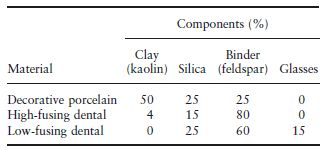Dental ceramics are mainly composed with crystalline minerals and glass matrix.
Composition of dental ceramics.
This article is a review of dental ceramics.
Several modifications have been made in ceramics in order to address this quandary.
Dental porcelain also known as dental ceramic is a dental material used by dental technicians to create biocompatible lifelike dental restorations such as crowns bridges and veneers evidence suggests they are an effective material as they are biocompatible aesthetic insoluble and have a hardness of 7 on the mohs scale.
Many dental ceramics contain a crystal phase and a silicate glass matrix phase.
Esthetically these materials are preferred alternatives to the traditional materials in order to meet the patients 39.
Part i reviews the composition structure and properties of dental ceramics from the literature available in pubmed and other sources from the past 50 years.
Over the last decade it has been observed that there is an increasing interest in the ceramic materials in dentistry.
Crystalline minerals include feldspar quartz and alumina and perhaps kaolin as glass matrix 1 10 11.
Dental ceramics can be classified in a number of different ways including by their composition processing method fusing temperature microstructure translucency fracture resistance and abrasiveness.
Principal crystal phase or matrix phase processing method casting sintering partial sintering glass infiltration slip casting and sintering.
Dental ceramics may have some luminescence characteristics in common with domestic porcelain although the composition of the former generally differs from that of domestic porcelain having a high proportion of feldspar 80 versus 15 relative to kaolin 15 versus 70 to achieve translucent quality bailiff et al 2002.
Divided into two parts such as part i and ii.
Divided into two parts such as part i and ii.
Composition of dental ceramics and dental porcelain.
Dental ceramics are nonmetallic inorganic structures primarily containing compounds of oxygen with one or more metallic or semi metallic elements aluminum boron calcium cerium lithium magnesium phosphorus potassium silicon sodium titanium and zirconium.
For certain dental prostheses such as three unit molars porcelain.
The detailed composition of dental ceramics was discussed in table 2.
Anusavice uses or indications anterior and posterior crown veneer post and core fixed dental prosthesis ceramic stain glaze composition.
This article is a review of dental ceramics.
Part i reviews the composition structure and properties of dental ceramics from the literature available.

